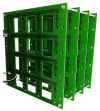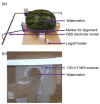Towards Tracking of Deep Brain Stimulation Electrodes Using an Integrated Magnetometer
- PMID: 33920125
- PMCID: PMC8068940
- DOI: 10.3390/s21082670
Towards Tracking of Deep Brain Stimulation Electrodes Using an Integrated Magnetometer
Abstract
This paper presents a tracking system using magnetometers, possibly integrable in a deep brain stimulation (DBS) electrode. DBS is a treatment for movement disorders where the position of the implant is of prime importance. Positioning challenges during the surgery could be addressed thanks to a magnetic tracking. The system proposed in this paper, complementary to existing procedures, has been designed to bridge preoperative clinical imaging with DBS surgery, allowing the surgeon to increase his/her control on the implantation trajectory. Here the magnetic source required for tracking consists of three coils, and is experimentally mapped. This mapping has been performed with an in-house three-dimensional magnetic camera. The system demonstrates how magnetometers integrated directly at the tip of a DBS electrode, might improve treatment by monitoring the position during and after the surgery. The three-dimensional operation without line of sight has been demonstrated using a reference obtained with magnetic resonance imaging (MRI) of a simplified brain model. We observed experimentally a mean absolute error of 1.35 mm and an Euclidean error of 3.07 mm. Several areas of improvement to target errors below 1 mm are also discussed.
Keywords: deep brain stimulation; image guided intervention; magnetic field mapping; magnetic tracking system; three-dimensional magnetometer.
Conflict of interest statement
The authors declare no conflict of interest.
Figures










References
-
- Lanotte M.M., Rizzone M., Bergamasco B., Faccani G., Melcarne A., Lopiano L. Deep brain stimulation of the subthalamic nucleus: Anatomical, neurophysiological, and outcome correlations with the effects of stimulation. J. Neurol. Neurosurg. Psychiatry. 2002;72:53–58. doi: 10.1136/jnnp.72.1.53. - DOI - PMC - PubMed
-
- Morishita T., Hilliard J.D., Okun M.S., Neal D., Nestor K.A., Peace D., Hozouri A.A., Davidson M.R., Bova F.J., Sporrer J.M., et al. Postoperative lead migration in deep brain stimulation surgery: Incidence, risk factors, and clinical impact. PLoS ONE. 2017;12:0183711. doi: 10.1371/journal.pone.0183711. - DOI - PMC - PubMed
MeSH terms
LinkOut - more resources
Full Text Sources
Other Literature Sources

